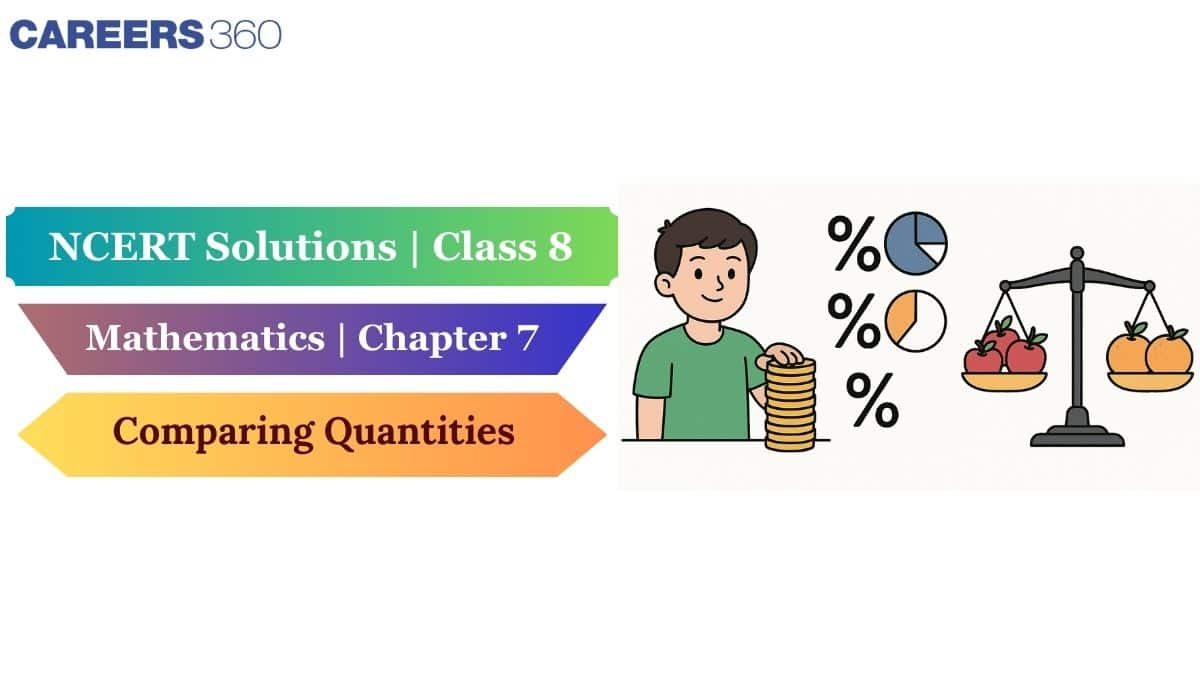Aakash Repeater Courses
ApplyTake Aakash iACST and get instant scholarship on coaching programs.
From understanding discounts in the market to seeing how your savings grow with compound interest, Comparing Quantities shows how ratios, percentages, taxes, and interest formulas connect maths to everyday life. When you buy a ₹1,000 shirt at a 20% discount, calculate GST on your bill, or check how your money grows in a bank using compound interest, you are using Comparing Quantities in your daily life. Mathematicians often use ratios, percentages and proportions to compare costs or values. For example, if an item is highly priced and increases in price by a percentage, then the total cost of all related items will also increase. Likewise, calculating interest helps us define how money can grow over time, or what extra we may pay over time. To make these concepts easier, the NCERT Solutions for Class 8 by Careers360 are aligned with the CBSE 2025-26 syllabus and pattern, ensuring that students learn and apply Comparing Quantities confidently.

Comparing Quantities teaches how numbers, savings, and spending are connected in reality. In Computing Quantities Class 8, students will learn how to solve practical problems involving percentages, profit and loss, discount, simple interest, and compound interest. The solutions address all the exercises in the NCERT textbook and include worked examples, real-world word problems, and simple steps to solve each problem. These NCERT solutions for Class 8 Maths Chapter 7 Comparing Quantities help the students cover all kinds of problems related to ratios, percentages, discounts, profit-loss, as well as simple compound interest. For the full syllabus mapping, simple notes, and PDFs, please visit: NCERT.
Students who wish to access the NCERT solutions for class 8, chapter 7, Comparing Quantities, can click on the link below to download the entire solution in PDF.
| Class 8 Maths Chapter 7 Question Answer: 7.1 Total Questions: 6 Page number: 81-82 |
Question 1(a): Find the ratio of the following.
The speed of a cycle is 15 km per hour to the speed of a scooter is 30 km per hour.
Answer:
The ratio of the speed of the cycle to the speed of the scooter
= 1:2
Question 1(b): Find the ratio of the following.
Answer:
To find the ratio, we need to make both quantities of the same unit.
We know, 1 km = 1000 m.
Therefore the required ratio =
= 1 : 2000
Question 1(c): Find the ratio of the following.
Answer:
To find the ratio, we first make the quantities of the same unit.
We know, that Rs. 1 = 100 paisa.
Therefore, the required ratio =
= 1:10
Question 2 (a): Convert the following ratios into percentages.
Answer:
To convert a ratio to a percentage, we multiply the ratio by 100%.
Question 2(b): Convert the following ratios to percentages.
Answer:
To convert a ratio to a percentage, we multiply the ratio by 100%.
Question 3: 72% of 25 students are interested in mathematics. How many are not interested in mathematics?
Answer:
Given;
72% of 25 students are interested in mathematics
Therefore, 7 students (out of 25) are not interested in mathematics.
Answer:
Given,
Win percentage of the team = 40%
This means that they won 40 matches out of 100 matches played.
Therefore, they played a total of 25 matches in all.
Question 5: If Chameli had Rs 600 left after spending 75% of her money, how much did she have in the beginning?
Answer:
Let the amount of money Chameli had in the beginning = Rs. X
She spends 75% of the money.
Since she has Rs. 600 left.
Therefore, Chameli had Rs. 2400 with her in the beginning.
Answer:
Given,
Total number of people = 50 lakhs
Percentage of people who like cricket = 60%
Percentage of people who like football = 30%
Since the remaining people like other games,
= {100 - (60 + 30) } = (100 - 90) = 10%
10% of the people like other games.
Now,
| Class 8 Maths Chapter 7 Question Answer: 7.2 Total Questions: 5 Page number: 85 |
Answer:
Since the 10% discount is on all the items, we can calculate the Selling price by totalling the Cost price of all items bought.
Now,
Total Cost price(CP) of the items he bought
= CP of a pair of jeans + CP of two shirts
= Rs.(1450 + 850 + 850) = Rs. 3150
= (100- 10)% of Rs. 3150 = 90% x Rs.3150 = Rs. 2835
Answer:
Given,
Cost price of the TV = Rs. 13000
Sales tax at the rate of 12%
= CP + Sales Tax
= CP + 12% of CP
= 112% of CP
=
Answer:
The discount given was 20% which means if CP is Rs. 100 then the SP is Rs. 80
For SP of Rs. 1600,
CP
Question 4: I purchased a hair dryer for Rs 5,400 including 8% VAT. Find the price before VAT was added.
Answer:
Given,
VAT = 8%
Let the original price be Rs. 100
Original price + VAT = Rs. 100 + Rs.
Original price + VAT = Rs. 100 + Rs. 8 = Rs. 108
Answer:
Given,
GST = 18%
Cost with GST included = Rs. 1239
Cost without GST = x Rs.
Cost before GST+ GST = cost with GST
Price before GST = 1050 rupees
| Class 8 Maths Chapter 7 Question Answer: 7.3 Total Questions: 3 Page number: 89 |
Question 1(i): The population of a place increased to 54,000 in 2003 at a rate of 5% per annum
(i) Find the population in 2001.
Answer:
Let the population in 2001 be P
Compound rate of increase = 5% p.a.
The population in 2003 will be more than in 2001
Time period, n = 2 years (2001 to 2003)
Therefore, the population in 2001 was 48980 (approx)
Question 1(ii): The population of a place increased to 54,000 in 2003 at a rate of 5% per annum.
(ii) what would be its population in 2005?
Answer:
Let the population in 2001 be P'
Compound rate of increase = 5% p.a.
The population in 2005 will be more than in 2003
Time period, n = 2 years (2003 to 2005)
Therefore, the population in 2005 will be 59535 (approx)
Answer:
Given,
The initial count of bacteria, P = 5, 06,000 (Principal Amount)
Rate of increase, R = 2.5% per hour.
Time period, n = 2 hours
(This question is done in a similar manner as compound interest)
Number of bacteria after 2 hours =
Therefore, the number of bacteria at the end of 2 hours will be 531616 (approx)
Answer:
Given,
Principal = Rs 42,000
Rate of depreciation = 8% p.a
Loss: Loss = Cost price - Selling price
Profit or Loss Determination:
If SP > CP, then it is a profit.
If SP = CP, then it is neither a profit nor a loss.
If CP > SP, then it is a loss.
Discount: Discount = Marked Price - Sale Price
Discount Percentage: Discount % = (Discount × 100) / Marked Price
Profit Percentage: Profit Percentage = (Profit / Cost Price) × 100
Loss Percentage: Loss Percentage = (Loss / Cost Price) × 100
Percentage Increase: Percentage Increase = (Change in Value / Original Value) × 100
Simple Interest: Simple Interest = (Principal × Rate × Time) / 100
Compound Interest Formula: Compound Interest = Amount - Principal
Sales Tax or VAT: Sales tax or VAT = (Cost Price × Rate of Sales Tax) / 100
Billing Amount: Billing Amount = Selling price + VAT
The topics discussed in the NCERT Solutions for class 8, chapter 7, Comparing Quantities, are:
Recalling Ratios and Percentages
Finding Discounts
Sales Tax/Value Added Tax/Goods and Services Tax
Compound Interest
Deducing a Formula for Compound Interest
Applications of the Compound Interest Formula
Access all NCERT Class 8 Maths solutions from one place using the links below.
Students can find subject-wise solutions for various subjects from the links below.
The following links will take students to the latest CBSE syllabus and some reference books.
Exam Date:22 July,2025 - 29 July,2025
Exam Date:22 July,2025 - 28 July,2025

Take Aakash iACST and get instant scholarship on coaching programs.

This ebook serves as a valuable study guide for NEET 2025 exam.

This e-book offers NEET PYQ and serves as an indispensable NEET study material.

As per latest syllabus. Physics formulas, equations, & laws of class 11 & 12th chapters

As per latest syllabus. Chemistry formulas, equations, & laws of class 11 & 12th chapters
As per latest 2024 syllabus. Study 40% syllabus and score upto 100% marks in JEE